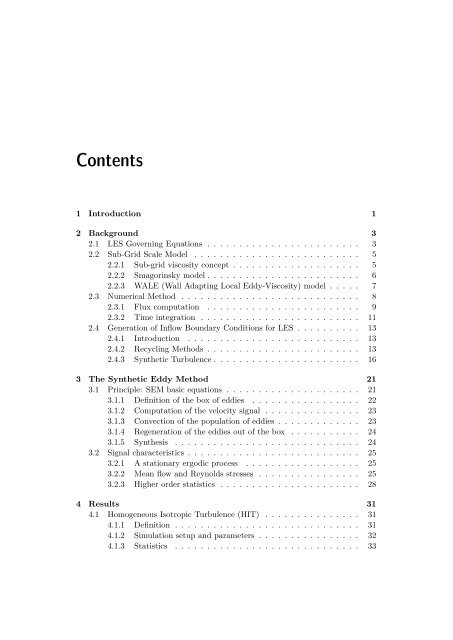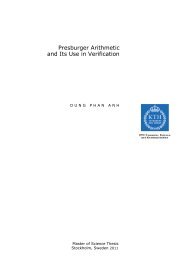Synthetic Inflow Condition for Large Eddy Simulation (Synthetic - KTH
Synthetic Inflow Condition for Large Eddy Simulation (Synthetic - KTH
Synthetic Inflow Condition for Large Eddy Simulation (Synthetic - KTH
You also want an ePaper? Increase the reach of your titles
YUMPU automatically turns print PDFs into web optimized ePapers that Google loves.
Contents<br />
1 Introduction 1<br />
2 Background 3<br />
2.1 LES Governing Equations . . . . . . . . . . . . . . . . . . . . . . . . 3<br />
2.2 Sub-Grid Scale Model . . . . . . . . . . . . . . . . . . . . . . . . . . 5<br />
2.2.1 Sub-grid viscosity concept . . . . . . . . . . . . . . . . . . . . 5<br />
2.2.2 Smagorinsky model . . . . . . . . . . . . . . . . . . . . . . . . 6<br />
2.2.3 WALE (Wall Adapting Local <strong>Eddy</strong>-Viscosity) model . . . . . 7<br />
2.3 Numerical Method . . . . . . . . . . . . . . . . . . . . . . . . . . . . 8<br />
2.3.1 Flux computation . . . . . . . . . . . . . . . . . . . . . . . . 9<br />
2.3.2 Time integration . . . . . . . . . . . . . . . . . . . . . . . . . 11<br />
2.4 Generation of <strong>Inflow</strong> Boundary <strong>Condition</strong>s <strong>for</strong> LES . . . . . . . . . . 13<br />
2.4.1 Introduction . . . . . . . . . . . . . . . . . . . . . . . . . . . 13<br />
2.4.2 Recycling Methods . . . . . . . . . . . . . . . . . . . . . . . . 13<br />
2.4.3 <strong>Synthetic</strong> Turbulence . . . . . . . . . . . . . . . . . . . . . . . 16<br />
3 The <strong>Synthetic</strong> <strong>Eddy</strong> Method 21<br />
3.1 Principle: SEM basic equations . . . . . . . . . . . . . . . . . . . . . 21<br />
3.1.1 Definition of the box of eddies . . . . . . . . . . . . . . . . . 22<br />
3.1.2 Computation of the velocity signal . . . . . . . . . . . . . . . 23<br />
3.1.3 Convection of the population of eddies . . . . . . . . . . . . . 23<br />
3.1.4 Regeneration of the eddies out of the box . . . . . . . . . . . 24<br />
3.1.5 Synthesis . . . . . . . . . . . . . . . . . . . . . . . . . . . . . 24<br />
3.2 Signal characteristics . . . . . . . . . . . . . . . . . . . . . . . . . . . 25<br />
3.2.1 A stationary ergodic process . . . . . . . . . . . . . . . . . . 25<br />
3.2.2 Mean flow and Reynolds stresses . . . . . . . . . . . . . . . . 25<br />
3.2.3 Higher order statistics . . . . . . . . . . . . . . . . . . . . . . 28<br />
4 Results 31<br />
4.1 Homogeneous Isotropic Turbulence (HIT) . . . . . . . . . . . . . . . 31<br />
4.1.1 Definition . . . . . . . . . . . . . . . . . . . . . . . . . . . . . 31<br />
4.1.2 <strong>Simulation</strong> setup and parameters . . . . . . . . . . . . . . . . 32<br />
4.1.3 Statistics . . . . . . . . . . . . . . . . . . . . . . . . . . . . . 33

















